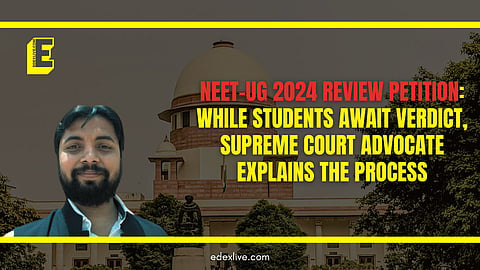NEET-UG 2024 review petition: While students await verdict, Supreme Court advocate explains the process
When is a review petition filed? Can it be filed with any of the courts? What is the process?
Let’s start by examining how the litigation process begins.
In the Supreme Court, initiating a legal action involves filing a petition. This can take the form of a writ petition, a Special Leave Petition (SLP), a civil appeal, or a simple application, depending on the nature of it.
Typically, individuals can challenge petitions that directly violate their fundamental rights, allowing those cases to go to the Supreme Court. Additionally, cases or tribunals from the high court can be forwarded to the Supreme Court if they fall within its jurisdiction.
Article 137 of the Constitution allows for the review of previously issued judgements, while Article 145 grants judges the authority to establish rules for hearings and other processes, and hence, reviews can be taken up in the court and will be produced before these judges who will use their own discretion over the matter.
Once the Supreme Court has ruled on an original petition or lawsuit (be it of any nature), the petitioner may file for a review of that decision.
It's important to note that not every litigant can seek a review after a judgment has been made. A review is not a rehearing of the case or an appeal from the high court to the Supreme Court, and does not involve moving a case from a panel of two judges to three or more.
When does the Supreme Court decide to review a petition?
In a review, there are two specific grounds for consideration: First, if new evidence emerges that could alter the judgement and was previously unknown to the party seeking the review. Second, if there is a visible error in the record that may have been overlooked.
Who can file these review petitions?
The litigant and the party involved in the original case can file for their petitions to be reviewed again, but that will be subject to the conditions mentioned above or can be summarily dismissed.
How do the proceedings of the review petition take place?
There are two main ways in which a review petition is typically considered. Most commonly, these are handled through in-chamber proceedings, which are not accessible to the public.
Unless there are special circumstances that require it, these proceedings are generally conducted via circulation or take place in a private chamber. Open court proceedings occur at the discretion of the judges, who may decide to hold them publicly if deemed appropriate for the case.
Do the same judges who delivered the previous verdict look into the petition again?
The same panel of judges will review the case unless a judge has retired. In that case, the chief justice will decide who will replace the retiring judge. If the chief justice is retiring, the newly appointed judge will assume the responsibilities and act as they deem fit.
How is the verdict delivered in a review petition? How soon is the verdict delivered?
We cannot say that there are fixed timelines for the court's operations.
As the apex court, it regulates its own procedures and establishes its own rules under Article 145 which gives it powers to do so. While it's difficult to predict how long a decision will take, but, if a case is listed, it will be resolved without delay.
Is a review petition considered a matter of importance?
The determination of a matter's importance is subjective, one cannot say that one issue is more important than another. Every case has both subjective and objective elements, which also applies when it comes to reviewing petitions.
Ultimately, the success of a case is dependent on its merits, and it is the court's decision whether to give thorough consideration to the matter.
How can one know about the decision taken while reviewing the petition?
It will be released like any other court order, similar in nature to the original judgment. If it is listed for an open hearing then you can watch the proceedings as well.
Is there any way to get updates on the petition?
It can be tracked on the website of the Supreme Court, from the details of the petition number. Courtroom, details of the judges, number of the listing, its status, and other relevant details are available.
If the review petition is dismissed, is there a provision to get it reviewed again?
There are no "re-reviews" of reviews. There was a judicial invention back in 2002 in the Rupa Ashok Hurra case, which is called a curative petition.
It is a special jurisdiction that the Supreme Court has carved out for itself, under the provisions of the Constitution to look into the judgement passed in the review if gross injustice has been found, there is an apparent bias in the face of the record and other special circumstances.
It is an extraordinary jurisdiction and sparingly used in the rarest of the rare cases.
Are the processes behind review petitions extremely rigorous?
Unlike in a petition, the burden is higher here.
In a review petition, it is upon the petitioner to lay out the details of the circumstances and evidence in a detailed manner, or else the case may collapse. There is a principle in law that says, it is not wise to unsettle the settled matter, hence the court may try not to prod into the matter too much if there is no crucial piece of information. Hence, the rigorousness of the case is subjective.
With regards to the NEET UG matter, individuals opined that review petitions usually do not overturn the main verdict. What do you think?
Most often the review petitions are not dismissed, but probabilities are low that there will be a new verdict on the case. It is upon the litigants how efficiently they have built the case, but the chances are less for a review petition to succeed.



